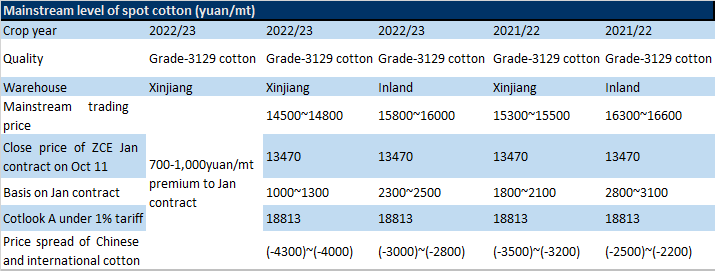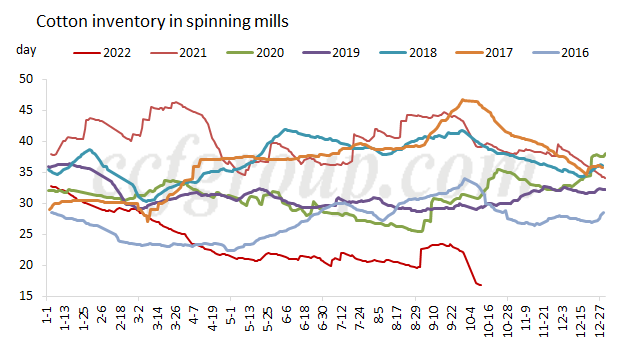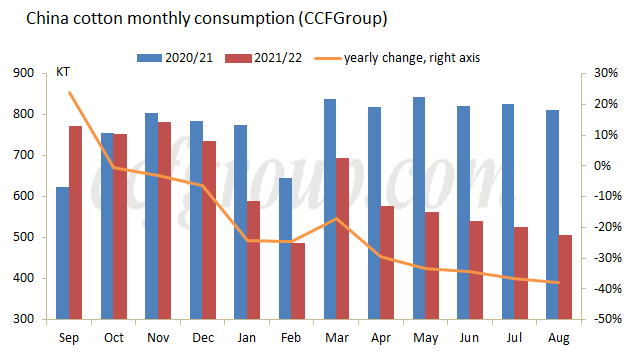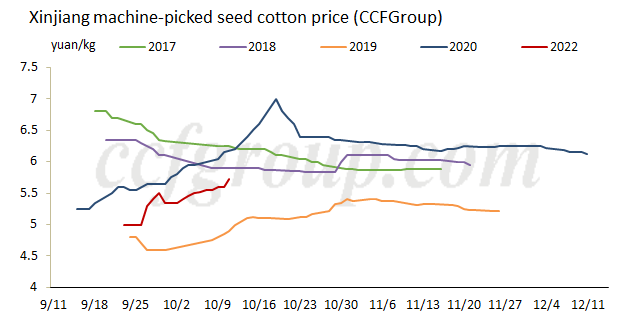Influences of the epidemic in Xinjiang on cotton market
The epidemic situation in Xinjiang becomes severe again during National Day holiday (Oct 1-7), not only dragging down the arrivals of seed cotton, but also making the transportation from Xinjiang to inland more difficult, resulting into lower cotton inventory in spinning mills. On the first day returning from the holiday, cotton prices in inland warehouses moved up, supportive to ZCE cotton futures market somewhat. But does the epidemic in Xinjiang only impact the cotton supply? Obviously No. Part of spinning mills has started to cut production due to lack of feedstock. Then how about the spot cotton market situation in Oct?
1. Spot cotton prices differ much and small quantity of new cotton is transacted
On the first day returning from the holiday, machine-picked new cotton has been transacted, and small quantity of new cotton is transported to inland warehouses. Currently, spot cotton prices have big differences as new cotton prices are low with low costs, while old cotton prices are firm affected by the epidemic. The price spread between old and new cotton, between cotton in inland warehouse and cotton in Xinjiang warehouse is both large. Meanwhile, basis continues to rise and the price spread between Chinese and international cotton narrows.

The table shows the mainstream trading prices of spot cotton currently. It can be seen that the price differences on spot market are very large. The price spread between old and new cotton is about 500-1,000yuan/mt, and that between cotton in inland warehouse and cotton in Xinjiang warehouse about 1,000-1,300yuan/mt. Nevertheless, arrivals of new cotton are limited, so more spinners have to purchase high-priced old cotton. Transactions focus on old cotton at present. (Note: CCFGroup Chinese cotton 3128 price includes trading price of new cotton, old cotton in Xinjiang warehouse, old cotton in inland warehouse. Currently, the actual trading volumes of new cotton are limited, so its proportion is low.)

2. Cotton inventory in spinning mills has been at a multi-year low, and some spinners have cut production due to lack of feedstock
As the cotton transportation and arrivals of new cotton is impacted by the epidemic, cotton inventory in spinning mills has been at a very low level, and spinners have to purchase high-priced cotton. But downstream demand is hard to support the yarn prices. After the National Day holiday, cotton yarn and grey fabric sales weaken, and yarn prices slip. Based on cotton price of 16,300-16,600yuan/mt in inland warehouse, cotton yarn sees a loss of about 700yuan/mt. Some spinners are unable to purchase the high-priced cotton in inland warehouses, and have to purchase Xinjiang cotton, waiting for the transportation. Under such condition, some spinners have already cut operating rate, overshadowing on cotton consumption. For late market, with the multiple outbreaks of epidemic, spinners are not very optimistic about the end-user consumption.


3. Seed cotton prices rise, but procurement progress is less than 15%
Xinjiang machine-picked seed cotton prices move up somewhat during the National Day holiday and after the holiday, up to 5.5-6yuan/kg. Bases on 2.85yuan/kg of cottonseed price, machine-picked cotton costs are at 12,000-13,400yuan/kg on theory. A few ginners insist to purchase at 5.2-5.3yuan/kg. But only a few ginners can procure seed cotton normally in Xinjiang as lots of regions are under static management affected by the epidemic. Ginners that can operate only purchase seed cotton nearby and growers are unwilling to sell. Therefore, it is supposed that less than 15% or even 10% of seed cotton is procured by now. The pressure for growers is increasing gradually, and later, if growers sell intensively, seed cotton prices are likely to fall down. In medium run, cotton prices are still easy to decline but hard to increase.

- Top keywords
- Cotton Price
- Cotton Futures Price
- Cotton Futures
- CZCE
- PTA Futures Price
- Chemical Fiber
- Polyester Prices
- Wool price
- PTA Futures
- Shengze Silk
- China
- Yarn Price
- price
- China Textile City
- Fibre Price
- Benzene Price
- Cotton
- Index
- Cotton Index
- PTA
- fabric price
- NYMEX
- Top 10
- textile industry
- Spot Cotton
- Cotton Yarn
- Polyester Price
- Futures
- PTA Price
- cotton yarn price

